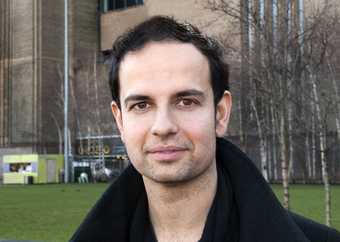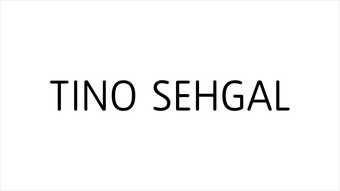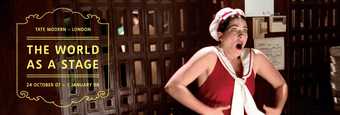Theatre, of course, is rubbish. It happens in the evenings, when there are more exciting things to do, and it does go on a bit. It typically involves people dressing up and pretending to be other people, putting on accents and shouting too much. Since visual art practice has so decisively repudiated, problematised, complicated the whole business of pretending, it’s hardly surprising that the theatre, still apparently a way of representing away in complete naïvety, should be given a wide berth, involving, not infrequently, disdainful glances.
Artists developing what came gradually to be known as performance, performance art or live art even founded their practice on a rejection of everything theatre had come to represent. Marina Abramovic, for instance, recalled her opposition: “Theatre was an absolute enemy. It was something bad, it was something we should not deal with. It was artificial… We refused the theatrical structure.” In the UK our cultural institutions, including public galleries and the commercial art market, have clearly embraced this position. Art (which can encompass performance, live art and dance) is cool; theatre is not. Theatre makes a show of itself in high-rent but tawdry locations, such as Shaftesbury Avenue, while art shows off its cultural capital by driving up rents wherever it goes. This distinction, as articulated by Ambramovic and sustained in much critical discourse since, rests on a misunderstanding of what theatre might be, even if it may reflect its condition in a certain mainstream situation. Theatre is still widely assumed to be about creating fictional representations of the world and presenting them to a largely passive public, either as entertainment, or as bourgeois self-improvement.
Enter Peter Handke. In 1966, at the Theater am Turm in Frankfurt, the “usual theatrical atmosphere” is maintained: curtains, ushers, programmes, house lights. A campaign of negation begins: “It may be the case that you expected what you are hearing now. But even in that case you expected something different.” The theatre announces the renunciation of all its familiar devices: “There is no drama. No action that has occurred elsewhere is re-enacted here. Only a now and a now and a now exist here. This is no make-believe which re-enacts an action that really happened once upon a time.” Instead the public itself becomes the subject of the encounter: “You look charming. You look enchanting. You look dazzling. You look breathtaking. You look unique. But you don’t make an evening. You are not a brilliant idea. You are tiresome. You are not a rewarding subject. You are a theatrical blunder. You are not true to life.”

Baktruppen
Homo Egg Egg as part of the Perfect Performance Festival, Kulturhuset, Stockholm 2003
Production photograph
© Baktruppen 2003
The event, it seems, has failed. In abandoning the attempt to re-enact anything that might once have happened, or might have been imagined to have happened, the theatre has failed to produce anything real, either. Not even the audience is “true to life”. Everything is contaminated by an air of fakeness. We have somehow blundered into a public space where we may look enchanting, but where we are, in reality, wherever that is, merely tiresome. In this double bind not even life itself can be true to life. How then, might we successfully pass as human beings, either in the theatre or in our natural habitat? Our natural habitat itself is already beginning to look rather worryingly like a theatre, or maybe a zoo.
In Publikumsbeschimpfung (translated into English as Offending the Audience) Handke used the structure of the theatrical situation itself to engage in a playful demonstration of the way in which that situation is designed, not to facilitate fictional representations, but rather to stage mediated and compromised encounters between human beings. The prime purposed of theatre is thus not to produce illustrations for an audience, but rather to produce audiences out of a special kind of encourage, an encounter in which error and misrecognition seem more likely than truth. In any event, it is clear that, from Handke’s perspective, theatre is not where we go to see stories acted out, although that might happen, it is where we go to watch ourselves watching and being watched. The theatre is always already relational, long before Nicolas Bourriaud proclaimed the arrival of relational aesthetics. Just as much recent art has revealed the subject of the museum to be the public, Handke’s work, and much that has followed it, is about what it means to participate, as singular individuals, in the formation of a public through the medium of the real, live encounter. All real, live encounters are, of course, mediated. Welcome to Spectatorland.
Spectatorland, by the way, is a location devised by Joe Kelleher, whose writings about the experiences of these strange public encounters sometimes take the form of “postcards from Spectatorland”, often dispatched from places in Europe where they do things differently. The Norwegian collective Baktruppen, for example, presented its 2002 show Homo Egg Egg in a theatre in which only projected images of the company were visible on stage via a live video feed from the space underneath the audience bleachers where the performers were going about their work. As Kelleher writes of this production and the work of Latvia’s New Riga Theatre:
What happens, happens as a sort of testing of the real that has to do with a feeling out of the proximate, the other stuff that is also here, a recognition if you like of neighbours, whose other worlds – be they over our heads or under our feet or right beside us in the same room – overlap and (potentially) interact with our own.
In anther corner of Spectatorland the screws are being tightened. In This Progress, presented at the ICA in 2006, Tino Sehgal produced a work which, while owing no obvious debt to Handke or any other theatrical practice, might fruitfully be thought of as theatrical. Entering the downstairs gallery at the ICA my friend and I were met by a boy of about nine who first introduced himself and then began a conversation by asking us what we thought progress was. The situation seemed to require an authentic response. To fake it would be condescending. There are strong ethical arguments against palming off comfortable clichés on young people. At the same time, I could draw upon the typical intellectual furniture of the left-leaning intellectual, offering recycled versions of creative destruction, summoning the ghost of the Communist Manifesto to intone, smugly, that “all that is solid melts into air”. But how hollow would that sound? Not only would my nine-year-old interlocutor detect the humbug like bullshit on a stick, my friend would see right though it too. At that moment, for sure, she was watching me struggle with this nasty social predicament. And I was watching her, doing the same thing. Waiting, in fact, for her to speak first. As if that would let me off the hook. Eventually, we dredged up between us some basis for a conversation about the positive and negative values associated with progress, until, after a few minutes and a walk across the gallery space, we were introduced to a girl, somewhat older than the boy. The boy handed us over to our new conversation partner with a succinct summary of our views on progress, which was both so accurate and so damning in its glibness that I felt terribly ashamed of myself.
What this encounter, and the affective response it produced, depended upon was distance and representation. There is distance everywhere, even if it is almost always distance that we feel as proximity. We are all three (or four) of us trying to get along, to make the social thing function, but we all know, too, that this is no social thing, at least not in the ordinary, everyday way. We are in an art gallery, for a start: it is as though our conversation was already pinned up on the wall for inspection. The distance between us may look tiny when compared with that created in a theatre between an actor on stage and a spectator in the back row of the auditorium, but it is just as effective and involves the same process: representation. Even if we were to go “backstage” (and that is precisely where This Progress is about to take us, through the corridors and stairways of the ICA), we would never get “behind” our interlocutors, we would never be “in on it” in the way that they are, never get outside the representation. In spite of the effort to cook up an actual live conversation (precisely what so much theatre is always labouring so earnestly to achieve), the set-up depends upon the encounter between the participating objects being, in effect, scripted. It is not the scriptedness as such that makes it theatrical, however. It is the distance it places between me and myself, the gap between the various versions of my own authenticity that it opens up. I watch myself struggling to respond and wince at my own failure to present a self I am comfortable living with. The distance mediated the encounter at every level. Nothing is ever immediate. We appear only by means of representation, and at a distance. We appear always, that is, as spectators. It is this distance across which representation occurs that makes this experience of Sehgal’s work a theatrical one, and which encourages me to consider it in the light of other work currently being made out of theatre.
The Italian collective Kinkaleri concluded a three-part exploration of theatrical representation with its 2004 production I Cenci/Settacolo. The piece takes the first part of its title from Antonin Artaud’s play The Cenci. The second part is the Italian word widely used to refer to a theatrical production: spettacolo. It suggests that, all appearances to the contrary, this production is proper theatre. From the very beginning of the show, the conditions by which we are accustomed to accept that something is un spettacolo, proper theatre, are painstakingly observed – that is to say they are both met and placed under a spectacular kind of scrutiny.
The stage is bare, with a grey floor, black curtains around three sides. A microphone on a stand is placed towards downstage left. The lights come up. Three basic conditions of theatricality: a space arranges for the benefit of the public, an amplification device to make sure that we can hear and an illumination device to ensure we can see. House, sound, lights. From the start the lights begin to function autonomously, passing through a sequence in which a series of perhaps six lanterns, each of which provides basic stage cover, albeit with a certain amount of shadow depending upon the direction of its throw, comes up and then fades, one after the other, so that we witness a series of lighting states, each of equal duration, following in orderly but meaningless progression. This basic sequence will be the lighting for the entire production. While its timings seem to vary, the show continues to move through each state with apparently no motivated connection between the states themselves and whatever action they might be illuminating: any moods, atmospheres or meanings generated by the relation of lighting to stage action are apparently entirely coincidental. What is striking is that the impact of this is not without affect. Moods do change; atmospheres are generated. The relationship between light and time is itself enough to do this. To add moving bodies to the space is immediately to open up such an enormous range of possible combinations of bodies in space and time that the affective possibilities start to appear incalculably vast. Suddenly the idea that you might bother to try laying over the top of this a secondary layer of representation – such as, for instance, dramatic narrative – seems almost entirely redundant. After all, we have only just started to explore what might be achieved without anyone even appearing on stage.
The microphone just stands there, awaiting the appearance of someone who might speak to us. No such person appears, at least not at first. Instead, as the lighting sequence begins a music track is played: Rod Stewart’s Do You Think I’m Sexy? For about two or three minutes this is the show: lights, an unused microphone and the song. Eventually someone emerges from behind the curtains and advances downstage holding up a duvet so that they cannot, as it were, be seen. This person lies down under the duvet for a while, and then gets up, still hiding, and exits, leaving on the floor a sign printed with the message “Houdini 1901”. Is this perhaps the only way out for a theatre that follows to the letter Artaud’s requirement that it should escape representation?
As Tate Modern’s The World as a Stage (24 October 2007 – 6 January 2008) invites us to consider again the relations between visual art and theatre, is it too much to hope that our cultural prejudices may shift a little, and that theatre might seem, for a moment, a little less “rubbish” and as capable as the next art form of examining its own productions with rigour and humour?



